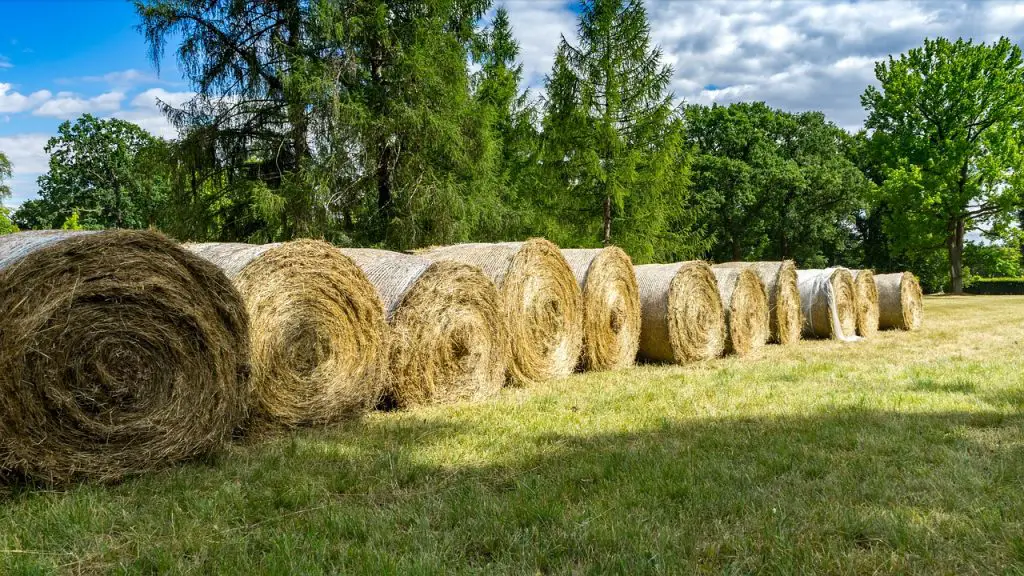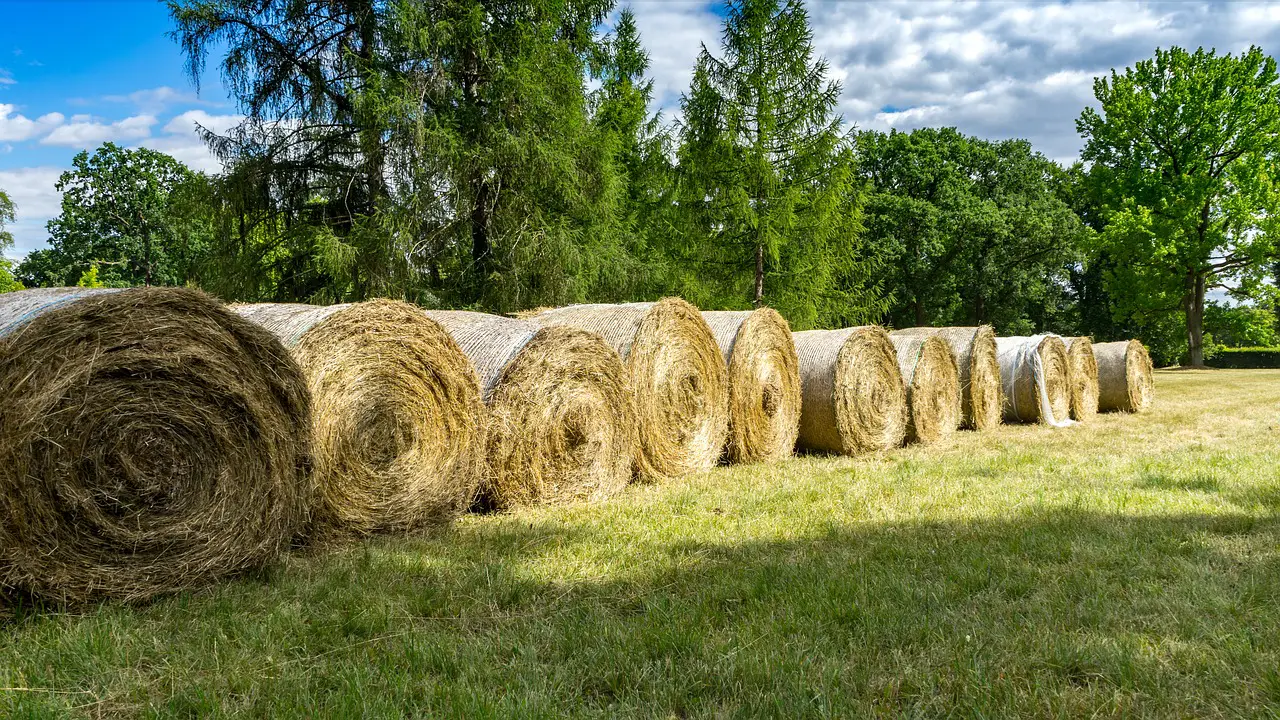Last Updated on February 24, 2022 by Allison Price
If pastures are not sufficient to allow livestock to graze, hay and grains are the only options. Many buyers, ranchers, and farmers struggle to determine the weight of a round bale hay. Particularly when vendors or farmers have to answer a customer’s question about the weight of a round bale of hay.
Not only is it important to know the bale weight for selling or buying hay, but also for determining farm inventories. It is difficult to know the exact weight and many sellers and buyers have had difficulty with this. Hay bales come in two basic shapes: square and round.
The most common bale shape is the round. This type of bale was first used on fields around 40 years ago. Horses and cattle are now fed hay in pounds, not in a variety of bales. There is no way around it; the buyer must know the weight of the lot before buying it.
Sellers may claim that the weight of each bale is the same as the actual weight. Buyers should weigh the bales on the scale at the feed store. We will provide a detailed answer, but we first want to tell you about hay and how it is made.Contentsshow
Hay: What is it?
Hay is made up of legumes, cut grass and other plants. It provides a better alternative to pasture, with all the necessary nutrients. Hay is used to feed cattle, horses, sheep, goats and guineapigs. Hay is compressed into bales. These are the types of hay that can be used to feed livestock

- Most parts of the globe, grass hays include bluegrass, Bermuda and brome.
- Common legumes include cowpeas and soybeans as well as trefoil, lespedeza and a variety of clover.
- Other types of hay grass include cereal grain crops, mixed grass, and legume.
Read the What’s a Flake of Hay?
What Does a Round Hay Bale Weigh in Weight?
Hay bales are generally between 40 and 2000 lbs in weight. Round hay bales can be quite large and weigh anywhere from 600 lbs up to 1200lbs. Round bales are more popular because they are easier to transport and handle.
Don’t rely solely on the numbers given above, as the weight and the diameter of each bale will vary.
The weight of hay can vary in size and density. Hay bales can be made by placing hay into the compression chamber of a baler. The machine then compresses, ties and packs the hay according to a specific dimension.
Bale making is not about weight. The bale weight is not something that is considered important. It is impossible to determine the exact weight of a bale of hay without measuring it with a scale. This scale does not allow you to estimate hay bales in.
The moisture content is another factor that affects weight. It is well worth mentioning. The hay bale’s moisture content has a significant impact on the weight. It is hard to make hay bales of identical weight due to their size, density, and moisture content.
Round Hay Bales Weight
Hay bales are available in a variety of sizes and weights, as was established previously. There are many sizes of round hay bales, from small to large. Below is an indication of the weight of round hay bales based on their dimensions (Width and Height).
- Small Round Hay bale –Small Round Hay Bale is often bought by farmers who have fewer animals to feed. It still produces sufficient hay, despite its small size. A small size bale with hay measuring 4 x 4 feet (W x H), usually weighs between 400 lbs and 600 lbs.
- Medium Round Hay BaleMedium-sized round bales are larger and heavier than the smaller ones. A medium round hay bale 5 feet x 4.5 feet in size would weigh between 720 and 950 lbs.
- Large Round Hay bale –Large circular hay bale can feed many livestock due to its size and weight. A 5 ft x6 ft round bale hay is heavier than the medium and small. It weighs between 1270 lbs and 1700 lbs. (source)
Factors that Influence the Round Hay Bale
As we have discussed, there are many factors that affect the weight of hay bales. Even though the hay bales may be the same size they will still have different weights. Before buying a hay bale, a buyer must prioritize two factors: weight and ease of handling (less storage space).
Hay can sometimes be of poor quality and very expensive. Certain hay types may contain toxic chemicals and other additives that can slowly affect the animal’s health.
Let’s take a look at these factors one-by-one
Size
When buying a bale of hay, size is important. The size and weight of the bale are important factors. Farmers often look at the bales to determine their weight. It is most likely incorrect as different sizes of bales can have different weights.
Hay is purchased by weight and not by bale size. It may seem difficult to negotiate or complete the transaction but you will get a great deal.
Density
The bale’s weight is determined by its density. A bale that is more dense will weigh more. The bale’s construction and the amount of compression applied will have a significant impact on its weight. The weight of a hay bale is affected by its tightness and compression.
A tightly compressed bale of hay is more heavy than a loose one. Most balers allow you to customize your settings. Others offer compression options that are tighter than the standard equipment.
Species
Below are a few types hay grass species. Each has its own plantation method, fertilization technique, maturity and weight. Each forage type has a different weight.
Forage maturity
This is the most important factor, but the biggest one. It has a significant impact on the bale weight. The density of hay is affected by the maturity of the forage. The plant’s fiber content decreases as it gets older, which makes it less dense.
Moisture Content
When hay is baled, its moisture content will affect the weight. To ensure that the grass is evenly dried before baling, haymakers fluff it. The nutritional value of the cut grass can be preserved by bailing at the right moisture level.
To prevent hay mould or overheating, the ideal moisture content for square and round bales is 22% and 18% respectively. A percentage of the moisture content is included in the hay bale.
The bale weight can be affected by the moisture level. Simply put, the more moisture the bale has, the heavier it will be. A bale that weighs 100 lbs is reduced to 80 pounds by placing it in a drying oven to remove moisture. The bale contained a 20% moisture content.
Putting all this together, determining a bale’s weight can be more complicated than expected. The only way to find out is to weigh it on a weighing scale. Bales of different sizes can have different weights due to many factors.



